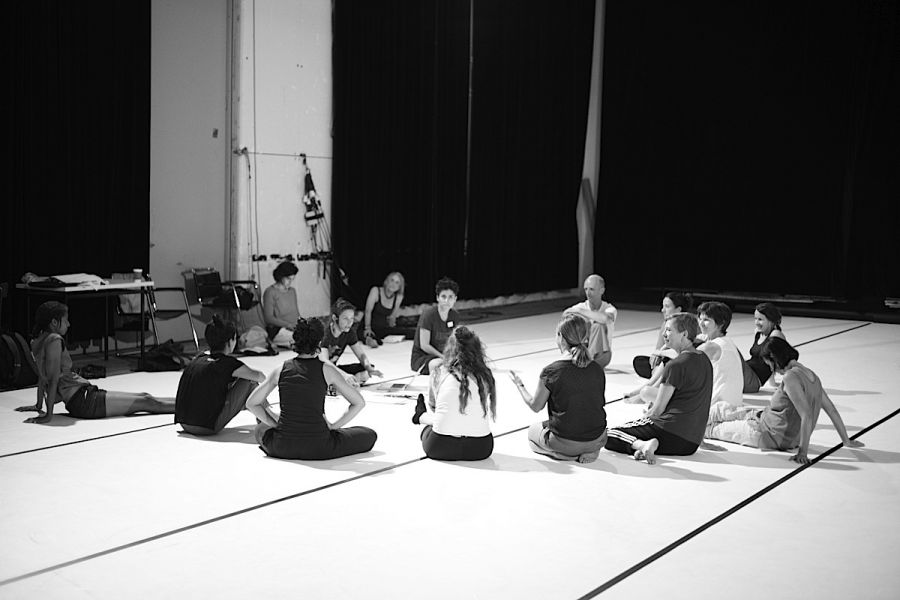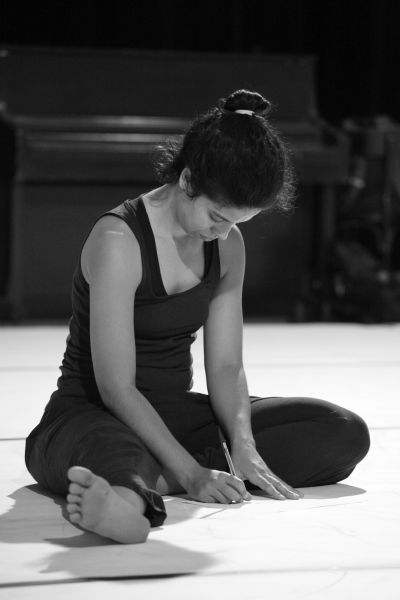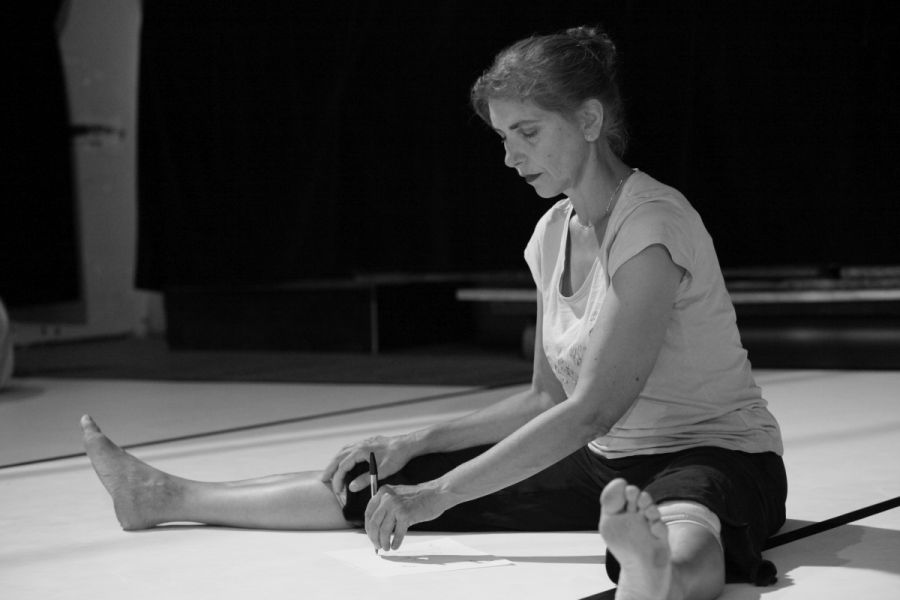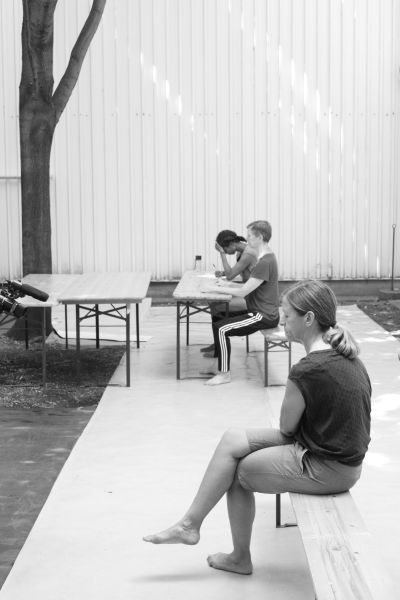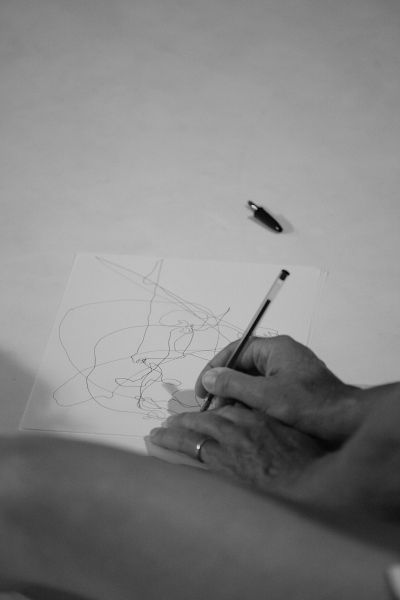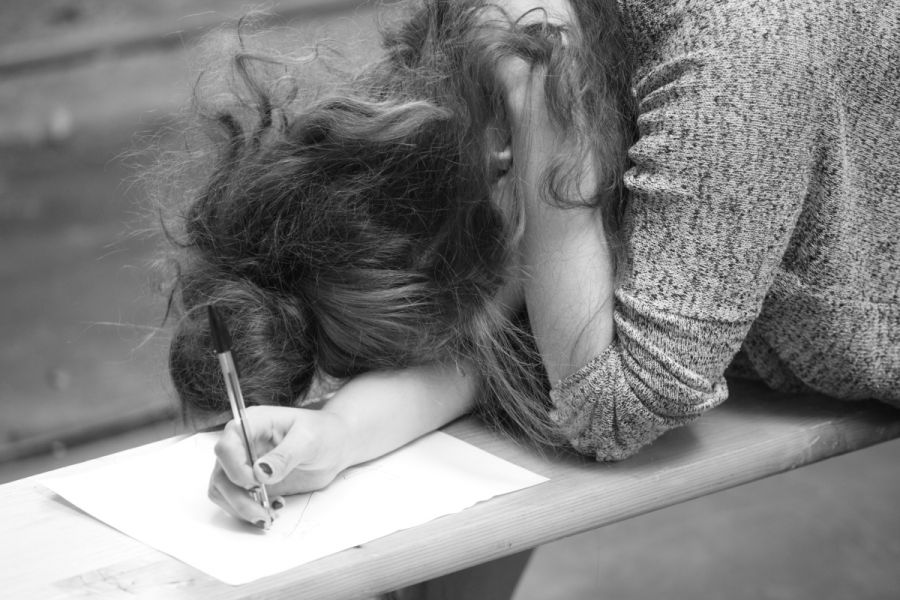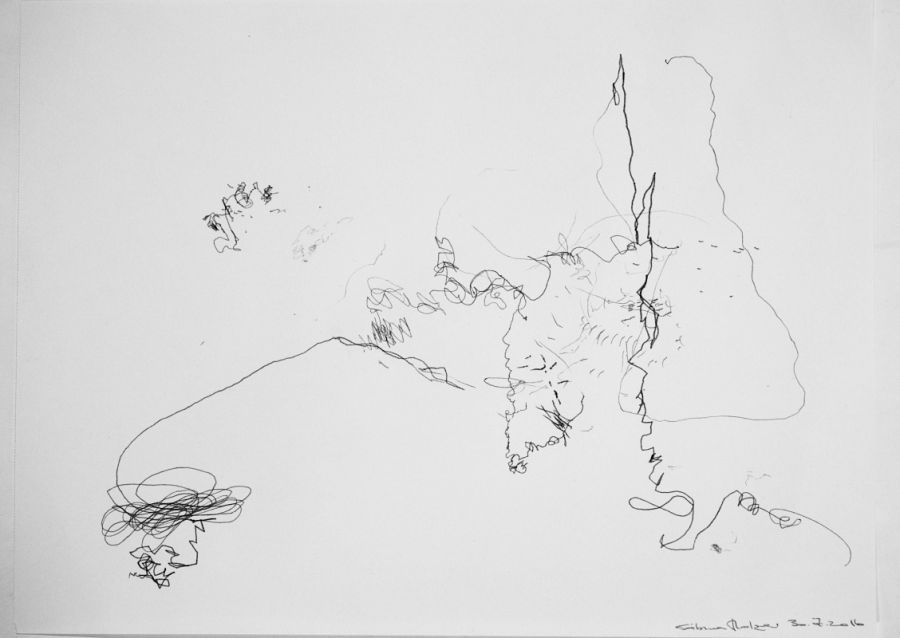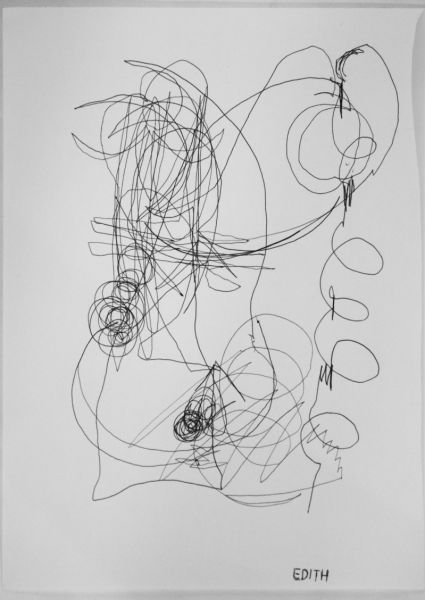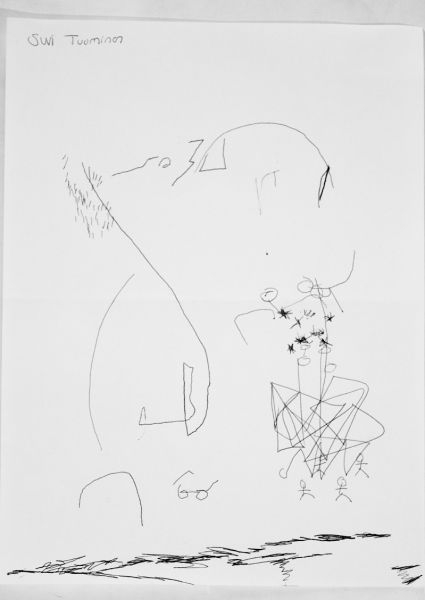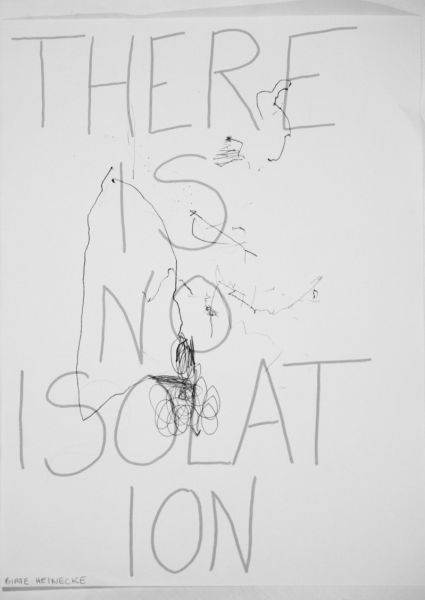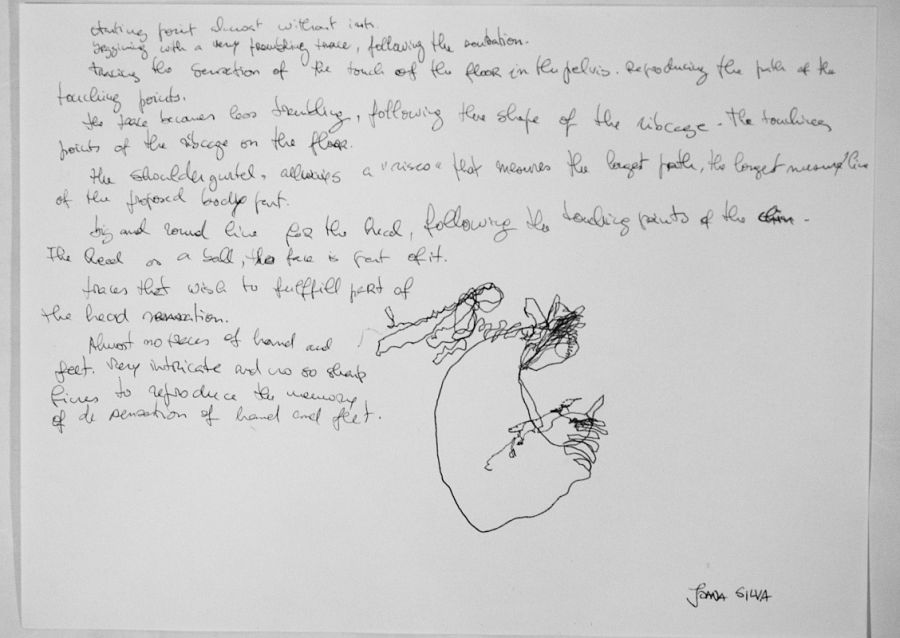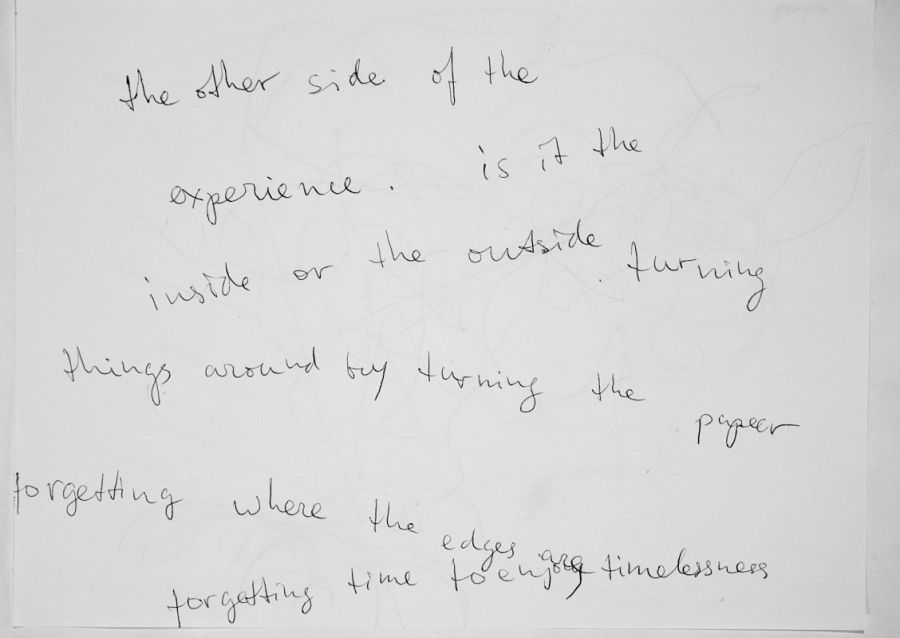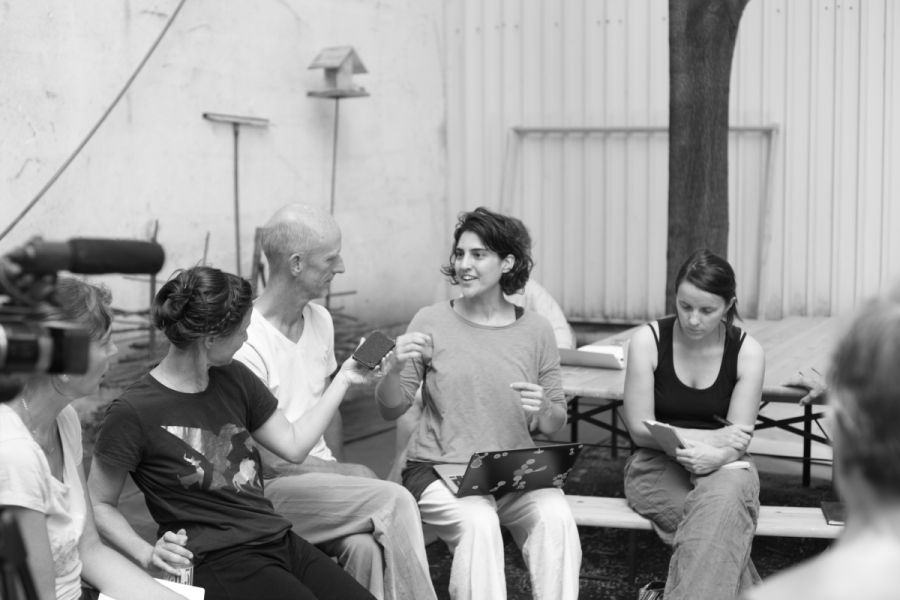10th of august 2016 Aix -en-provence, France
Preamble
Documentation is for me a process without beginning and end. It is a movement, a cyclic one. It is a spiral that moves forward by revisiting, re-experiencing ‘things’ from the past: knowledge in the form of sensations, affects and thoughts. It is is an ecological process that proposes to move on through recycling experiences. I apply this recycling process to create this IDOC. I re-visit/ re-compose "Drawing as a tool for poetic and polyphonic dance documentation" I gave during the 4th IDOCDE symposium in July 2016. I use writing and the different kinds of traces produced during the session itself: notes, drawings, pictures, texts, audio and video.I write at the present time because for me memories are presents experiences. I try to follow a chronological order though this order is sometime distrubed by a reflexion that came after.
Vienna 31st of july 2016
Participants: Andrea Keiz, Sabina Holzer, Barbara Meneses,Edith (name is missing), Hazal Kaya, Birte Heinecke, Benno Voorham, Sybrig Dokter, Claudia Kappenberg, Bertha Bermudez, Joana Silva, Suvi Tuominen,
Observers: Nita Litle, Defne Erdur, Friederike Lampert
Photograher: Martin Streit
Videographer: Zoltán Nagy
Introduction: People are sitting in circle. I read the presentation of the Reflex Europe project that is written on the symposium program: REFLEX Europe is a gathering of 11 international dance teachers, movement researchers and artists who jointly reflect and develop proposals on how to support your process in the field of dance / performance teaching and research by artistic documentation.
Note: we also talk about reflexive documentation
I give the structure of the class: we are going to move, draw, write, select, share and talk.
I introduce Defne Erdur, one of my Reflex Europe project's peer. I invite Defne as a "conversation partner" to observe the session. She will stay at the periphery of the room. I also introduce Nita Little that was proposed to me as a second "conversation partner". I already have an on going conversation with Defne and meet Nita for this occasion. Defne and Nita will join us for an "after talk" to reflect on the overhole session and discuss about the collection of drawings as a potential poetic documentation of the session.
M O V I N G
"The poor warm up" by Lisa Nelson
“Start sitting on the floor with our eyes closed. Bring your attention to the bones of your pelvis. Use the floor to visit
its various the bones, no sliding, no skipping, only rolling. The pelvis is the center of your attention. The rest of the
body organises itself to support your inquiry. If you notice that you always follow the same pathway, try to visit
unusual places. Continue the same practice around your rib cage, your shoulder girdle and shoulders and finish with
your head. It is almost a sphere; there is infinity of pathways. You can alternate exploring with your closed and your
eyes open. When your eyes are open, what do you see, what is touching your retina? Can you stay connected, at the
same time, to your tactile and kinesthetic sensation while seeing colors, matters, objects and people engaged in the
same practice around you? When you have finished with the head bring your attention to the bones of your hands ,
bones of your feet, legs and arms. As you are rising toward verticality, pay attention to the space between you and
others, limits of the studio and watch the composition of the room. You can travel if you feel like it. Take a moment to
go for whaterver you need, to complete you experience. Find an ending. Aknowledge the end. When it is over,
it is over."
I choose a warm up from Lisa Nelson that she tittles ”the poor warm up”. I remember her saying that she used this score before performing, finding herself, most of the time, in poor conditions, not having time nor space to warm up. She would practice "the poor warm up" in a small corner. I choose this warm up because I often use it myself and I have noticed that it is very efficient. It opens the body from the core: spine, perception and attention at once, all what one needs as an improviser. As I know it,the "poor warm up" finishes with the exploration of the bones of the head. I want that day to lead people towards standing and moving in space, so I add the section with the limbs, hands and feet.
I demonstrate before inviting people to do it themselves. I want to transmit a certain specificity. I demonstrate as I have seen Lisa doing it. I imitate her. We learn through imitation.
Participants practice "the poor warm up" for 30 minutes. I guide with words and sentences. I usually practice the score myself and let the words emerge from it. Here, I am talking while walking around the room and holding the voice recorder in my hand. I listen to what is present. I pay attention to what I see, hear, feel, think and imagine. I try to leave silence in between the sentenses not to overload people with invitations. I want to support and to give a lot of space for them to make choices and teach themselves from what they perceive and know already. Some of these sentences are kind of mantras that I often repeat in my classes. They are what I select from teachers I have met : Lisa Nelson, Deborah Hay, Fernand Schirren, Pauline Oliveros
your sensations are your guide
follow your interrest
what do you need now?
tasting your sensations
no need to bother about time
observing yourself
are you always following the same pathways?
if you are, what can you do to make a change?
do you want to change?
extremities organise themself to support your investigation
the body as a society
if you eyes were closed open them and if open close them
aknowledge the difference
you are touched by the light, by the air and by other people's
gaze
what is touching your retina – colors, actions, reflections, people?
rib cage is touching the floor and is touched by the floor
you don't need to move all the time
notice if you are in automatic pilot
pause
to forget
to refresh
to wait for a desire to emerge
tasting your sensations
tasting your thoughts
tasting your emotions
how are you?
bored?
happy?
can you Integrate what people are doing around you in your experience?
What do you need now?
conclude this experience with what you need now
you are with your self
with the room
with others
with the whole situation
look for an end
when it's over, it's over
After 30 minutes of movement exploration we go for the drawing session.
D R A W I N G
“The first step required by this approach is to get rid of the idea that drawing is about creating an image. In
the event, drawing is leaving traces. Traces of gestures, traces of feelings, traces of choices and thoughts”
Julien Bruneau
Edith
People gather in circle again. I put A4 drawing sheets and black ball pens in the center. I explain that I borrow and adapt a drawing practice from Julien Bruneau, a choreographer and visual artist I am collaborating with, as performer since 2010. I read an extract of a text Julien wrote to precise his pratice. It is very specific and relates to the poorness of Lisa’s warm up. We “only” use black ball pen to draw the experience of revisiting the movement exploration. The pen is a tracing device used as an extension of ourselves. No brush and ink, no color, no tools helping the trace to look more sexy or more interesting than it is.
People find a place to draw: on the floor in the studio, standing beside a table or outside in the court yard. It is really hot that day. They draw for 15 minutes. I continue walking around. Sometimes I look and smile at Defne that is taking a lot of notes.
I love to witness the presence of people engaged in the process of revisiting their experience. This activity is charging their body and change the quality of the space around them. My old rythme teacher Fernand Schirren was saying that dancer's are not dancing in space they are secreting space. Dance for me is no anymore about making big movement in space but about energetic radiation, about the quality of attention that modify my perception of time and space.
Barbara Meneses
Benno Voorham
Joana Silva
Sabina Holzer
Andrea Keiz, Sybrig Dokter, Berta Bermudez
As the needle of a seismograph, the black ball pen is tracing the internal life and state of attention of the person.To choose a black ball pen to draw reflects my interested in voluntary simplicity, my desire not to get distracted by all the possibilities and product that society invents for me to consume. I believe that one can do a lot with very little and in this ways develops internal strength and resources.
Claudia Kappenberg
Suvi Tuominen
Sabina Holzer
Edith
Suvi Tuominen
R E A D I N G - W R I T I N G - S E L E C T I N G
I propose to read the drawing on its material level: where are the traces on the pages? What is their quality and their depth? What can you learn about yourself, about your dance, about your experience while looking at these traces?
I then ask if people can observe how their memory is re-organizing events when they revisit their experience: is it chronological, continuous, fragmented, in disorder?
after 10 minutes of writing, I invite people to select a part of their writing to share with the group.
Birte Heinecke
Joana Silva
Edit
Benno Voorham
S H A R I N G - T A L K I N G
We gather in circle again. I ask who wants to share as we don't have time for everyone to do it. I propose to expose the drawing so we can all see it while listening. I record what people say with my phone. The audios are available below. I have given them a tittle extracted from the sharing.
- "There is no isolation" Birte Heinecke
- "The inside sensation leading the pen" Claudia Kappenberg
- "Moving feelings" Hazal Kaya
- "Burning focus" Edith
- "Layering of memories" Sabina Holzer
- "Visual memories" Suvi Tuuminen
A F T E R T A L K
I want to talk about the collection of drawings as a potential poetic documentation of the session. The conversation goes very wide. We reflect on my teaching and the progression through the differents stages and practices. Some very interesting comments comes out. I choose to mention one of Defne's comment that resonates with my interests and I also transcribed the second half of the discussion. If you want, you can listen to the full talk in the audio file.
Sabina Holzer, Anouk Llaurens, Benno Voorham, Defne Erdur, Birte Heinecke
Defne mention that different part of the brain are at work in the phases I propose. She mentions left and right brain. Indeed, moving, drawing, writting and talking activates different layer of the brain, different kinds of intelligence. I am interrested in the construction of intelligence and how brain's layers, from the more primitive one to the more recent one, support one another. These layers are inter-connected, touch is supporting vision that is supporting action that is supporting thought, that is supporting imagination. I give now a chronological line of support, following some kind of development pattern, but all these modes are working simultaneously. Since many years, I am mainly involved in trans-disciplinary artistic and performing work. I am used to slide/jump from one practice to another. This sliding and jumping is softening my brain, enriching my being and also my dancing.This is why I want to share this kind of process with others. This transdisciplinary practice leaves traces that I want to consider as potential reflexive and sometimes poetic documents.
I have transcribed the after talk from the 17"20' until the end.
Benno: Well, I enjoyed very much the drawing, the tactile sense of it. I started to play around with different ways of drawing: at some point I had the pen stable and I moved the paper instead of the pen, the paper was moving. That became a play, but it was very much connected to the memory and the sensation that was still in me. I had the paper on my chest at some point and drawing on my head... that kind of things. But the moment I started writing and I sat down here with my glasses, I went into something completely different. And for me it had actually very little, if anything to do - apart from a reflexion and trying to give words- with the actual experience that I had, both moving and still when I was drawing. So for me there is this huge gap between those two worlds. And also when I listened to much of what was said or what was written, I listened to the need to be beautiful with words which I find difficult.
Anouk: You heard the need to be beautiful with words?
Benno: To be well expressed with words. And the experience from moving was actually not, well, most of it, was not based on “I want to move beautifully'. Just at the very end,I went to that place for myself, I wanted to be on my feet and move, I needed to give that space to my body.
Anouk: You talk about going back to movement after the whole process of moving, drawing and writing or...?
Benno: No, I am talking about the last part of the moving. There was first a space from the more internal exploration of the pelvis etc and then you introduced the limbs the joints and that brought me on my feet almost immediately. I enjoyed to give a very different sensation of space in my body and playing with that in movement. For me that was the essential part.
Defne: Can I make a very short comment relating back to what I started with (the different parts of the brain). I don’t know the neurological aspect but it was more like, left-right brain. Also, when you are writing, you are using the analytic part of your mind already... I don’t know if it is 100% true ... but what was interesting for me, is that when people were drawing, they where more engaged with their bodies. Because the paper was very small and you where on this delicate floor and the exercise was to be done on the paper, it was a very limiting exercise. But then of course, the drawing itself is still playful, it’s art. I mean language of course can be art too. But then, again... the framing: we are in an artistic context already and then this urge to be aesthetic because we are documented, because I am not doing it for myself at home or may be it’s the training (...) but because it is in a presentation mode, it may be interpreted as the urge to be beautiful. I don't know... this is a question.
Anouk: I would also like to make an insert and remind us that it was a two hours and a half session dedicated to a very complex process. So may be, to be able to loosen up with the practice we are less used to, like writing, we need more time to get some sense of ease and confidence. I am really interested in the different layers moving, drawing, writing, talking and how they can complement each other. Drawing will not document the same aspect of the moving experience than writing. How can these layer/practices teach each other, and present different perspective of the same experience? Each practice/layers gives a certain kind of information. My interest is to be able to slide form one layer/ practice to another and see what practice documents what. What part of the experience are usually documented and by which practices? What kind of knowledge emerges from that? Can we find ways and tools to document information or experiences that are usually not documented?
Defne: And if you change the order and you start with writing, I would be curious.
Anouk: Yes! This is a whole research. We could go for so many experiments, playing with the order, and off course we need time to get use and be playfull with the different practices.
Nita: I think it is important to recognize the influence of the eyes on what we did. When we where writing, eyes where open. And I think those eyes are such a huge part of the brain, so much of the brain is devoted to sight. I think it is just an immense impact on how thinking happens and the loudness of sight that easily overwhelms the kinesthetic memory.
Edith: I don’t like the judgment to be honest (about writing "beautifully”). I think there is a difference talking about the experience or trying to go into the feelings with the words. And for me, there where some statements (while sharing the writing) that were talking about, in a very abstract way and I could not get the feeling and I think that other tried to describe with words the process. And it is another medium and off course, I will say that it is an artistic medium and it is another medium to try to describe and to try to give the taste. But it is the same option than to do it with the drawing. I am sure. And it was not quite clear if you wanted us to reflect on the process with our words and if you wanted us to describe it.
Anouk: Well, thank you. This is really helping me. It is an experiment so any kind of insight is very welcome. Usually I let "things" a bit open so people can do what come first for them. I am interrested in how people respond and in the diversity of the response. I am ok with analyse and ok with poetry.
Sabina: For me it is again and again surprising this division between words and movement. I think of course we are culturaly codified in this way very much, so it is maybe a kind of pattern. But somehow, I also think because we are experienced, there is a possibility of choice. I was also wandering why you demonstrate the movements. Then ok, I see that you give very open frames but still there is a need, obviously for you Anouk, for some specificity. So for me, this is the way you try to introduce a certain specificity within this open frame. Within what you are providing and within its specificity, I can still be really slow or quick or move, play with it also. And it was the same in the writing for me. Of course I was writing from left to right and even reading the image from left to right and then I thought “ahah interesting” but I did not write complete sentences all the time. So there is a seduction or again a pattern to "write beautiful", but not al the way through and not conditionally. I think there is also this playfulness, space for experimentation and discovery, - even though of course, I also chose to read out sentences at the end when I shared my writing and did not read my stumbling or my grammar mistakes,
Anouk: Yes, what does one choose to read?
Sabina: For me in the writing task there are also different choices offered: do I want to write now five analytic lines to capture the image or do I want to connect it to a different way of writing? What do I want to discover with / through writing words? There are all this ranges of possibilities in there. This is one thing. The other thing is, that I recently heard, that neuroscientists found out, that by processing impulses, the brain creates cognitve patterns and neurological patterns at the same time. It is not as we often think, that one comes sooner or later - first the neurological which is then translated into the cognitive cultural knowledge, or the other way round. It happens simulaneoulsy. I find that amazing. Does that mean that we have the choice, where to put our awareness? If language and cognitve understanding is created at the same time with abstract neurological pattering, we can also blend them, if we wish to. There are many artistc examples for that.
Nita: And people are not the same so the two side are not going to be equal in everyone. That’s a presumption.
Sabina: No no....
Nita: The interest is that for that person, there is domination by one side over the other.
Sabina: Yes, of course,
Nita: Or this moment of that person.
Sabina: Of course. I am just saying that for me there was this specificity and playfulness to either discover, yeah, I am now very right of left brainy, like attached to language also but also the choice to go to a different place.
Claudia: I was just thinking about your question about documenting the class. Well, in terms of the drawing that we did, it was a fraction of that. Which was off course my internal, the way I interpret that moment of the invitation to draw was off course my own journey, and I don’t feel that in that sense I documented the class.
Anouk: But do you think that the collection of these drawings could be a documentation of the class?
Claudia: It is very partial. Otherwise I would potentially draw the space and I would draw other body in the space and I would draw a sense of your voice in that space and all these kind of stuff you know.
Sigrid: But then we come back to what we did not talk about: what is documentation and what is it for? Because without talking about that you can’t say if it could be documentation, because if you ask this question of course it could.
Anouk: Yes, yes.
Nita: What I am hearing is documentation by itself is a value rather than documentation is a means to accomplish something. And what is that something that is being accomplished? And it seems to me documentation for the sake of documentation is “ ok life happens”, you know. And I want to know what is it that is valuable to you in this particular configuration or this particular pathway.
Claudia: I think that you can also document in the sense of simply tracing, so again you just focus on the process of tracing without initially having a purpose.
Anouk: I feel that there is, at least, one more layer to add. What I would like to do now is to look at these traces to read them, to see what is happening, what do they tell, what do I see, what do you see? or to I invite someone from the “outside” to look at these traces.
Benno: The limitation I feel with all the interesting side of it, is relating to the actual source we want to document. The source is the body, the source is movement. The moment, I started writing with my eyes closed, which I enjoyed, it was more fluid. It is what I am looking for, a kind of fluidity of mind that goes into automatic writing in a way, putting my thought at that moment, what come up on this paper. But the medium itself is something so completely different from what the source is so the documentation is actually what is in the nervous system of my body.
Nita: Not even in the nervous system but where the cellular intelligence is taking place, and it is not necessarily neurological.
Benno: The cells, on that level I have a memory and an experience and I feel the documentation is in the body. And still the moment we want to pass it to someone else we might need other media.
Anouk: Well, for me the documentation is everywhere, it is in the body, it is in the drawing, in the writing, in the talking. Writting, drawing, talking are are made by living people and in that sense they also are a reflexion of cellular intelligence.
Nita: Yes, but Benno is pointing to something that is really important for us as dancers. Your documentation process was a progression from a multiple level of intelligence, embodied intelligence, on more and more neurological intelligence. So it was a progression from something that is much more complex, to something that becomes far more culturally recognized as intelligence and what was going on that really profoundly physical level.
Anouk: Yes. I am aware of that and it is also why I am very interested in the incompleteness of the documentation and why I work with multiple points of views and fragments. I choose these strategies to say that "documentation is always just a fragment of the experience or something that points towards this fragment of reality, nothing more than that. I am aware of the gap, I am interested in it, in how to show this gap.
Edith, Anouk Llaurens, Benno Voorham, Defne Erdur
R E F L E C T I N G
I miss that we expose all the drawings side by side just to look at them all together to have a sense of the diversity of responses to the same movement score. It is very important for me to emphasize the polyphonic aspect of the documentation. Each participant is offering a singular perspective on the “same” object. In that sense my proposal relates very much to Andrea Keiz’s “(ex) change perspective”. Through polyphonic documentation, I want to highlight that history is a re-construction of reality with partial and subjective points of view. I am very aware that any documentation will never render the complexity of the dance experience. I use documentation in all its form, as a feedback, as a tool to return to the movement practice.
"drawing documentation as reflexive tool for poetic documentationis" is a title that only adresses one part of my proposal: the poetic and polyphonique documentation of a common movement experience. The Reflex project lead me to consider the documentation of the whole session, included what and how I teach. I guess this is why the after talk went wide and we did not specifically adress the question that I was interrested in. So I stay with these questions: Is the collection of drawings a poetic and polyphonique documentation of the common movement exploration? Can each drawing be the seed for the development of a personal and poetic dance notation? I will have to set up another lab to really work on these questions.
I choose this drawing practice because I believe drawing is a transitory stage between moving and writing. This is how we learn to write as child moving, drawing and writting. The practice I propose is a beautiful bridge for people/dancers that have difficulty or fear to write. Also the drawing happens with eyes closed which I always find a good strategy to forget about jugement. Writing happened with eyes open. I realise now that the movement and drawing score are very defined but the writing and talking score are still very open. I feel now the need to specify the the writing score to help people stay connected to their sensorial experience and their playfulness. Vision is very dominant and related to jugement so we can also practice again and again to use vision as a tactile sense, and consider what we see "only" for what it is: a color, a matter, a forms, a sensation, an affect that is nor beautifull nor ugly.
I am reflecting upon Benno and Nita comments about the documentation process being a simplification of the original source which is too complex to be documented. For me writing, drawing, talking are made by a living people and in that sense, they can be a reflexion of cellular intelligence if people stay connected to their physical experience while they write and talk. They are just different perspectives. And if we state that it is impossible to document a movement experience, to document life, what is this statement forces me to invent? First I don't believe that documentation has to be complete. And I don't want to give this illusion. I choose, subjective, mutimodal, polyphonic and poetic documentation to make sure that no body will consider this documentation as the thruth but as one possible and incomplete version of the original experience. My current research on poetic documentation of "hand eye coordination" led us (my parners and I) to create "live documents", performances as documents. These 'live documents' state that documentation already happens within the body and in the present. They want to state that live experience, somehow, can be considered as a document. Now, we are developping a practice that wants to state that the document is not the abstraction, the representation, the video, the book, the text. These objects are there to trigger an experience in the viewer or the reader and so the document becomes the experience of the reader or the viewer.
After listening to the lecture by Jochem Naafs (see "Lecture on Poetics/Poetic Lecture http://www.idocde.net/idocs/1611), I realyze that, in the lineage of Lisa Nelson, the documentation I generate is a kind of feedback. It is a feedback to myself and to the poeple that took part in the session. The principle of a feedback is that it stays within a group, it functions as a loop. In the contrary, documentation is open to anyone, also to people that where not present during the session. So I wonder what happens when a feedback is published as documentation and open to everyone? Is it "useful" to the people that where not there? What kind of information can it transmit to them? I do think that a feedback can definitely inspire some people. Inspiration is not quantifiable. When I look at some definition of the word I read: the movement of air into the lung; sudden creativity when a new invention is created - INSPIRATION is the primordial movement of life, and what keeps us alive.
REFLEX Europe PROJECT
The IDOC I create now is a combination of observation, comments, drawings, poetic sentences, audio recording, transcription of recorded conversation, pictures and video. It articulates several "languages" , media and points of views. I organise informations chronologicaly. Because of how the idocde web site is constructed, because of the tool itself, informations are organised in a linear way.
"Artists should make non-sense!"
John Cage
For my Reflex Tool and Guide contribution, I would like to deconstruct the chronology and the linearity of this idoc. I would also like to introduce the notion of chance and make non-sense with fragments of experience documented through the texts, audios, pictures and drawings. I imagine these fragments mixed, apearing and disapearing randomly at different places in the frame of the screen, like some memories can surface in any order, tirggered by the present experience and be forgoten again. I imagine deconstructing the linearity and chronology of events to generate a kind of order that alows collision to happen, un-expected associations that creates new sense. I also imagine blanck pages, like blacks out, that leaves time and space for oblivion and for the new to emerge.
As we are heading towards a digital publication, I am wondering what will be the tool that will allow my desire to take form...I am in dialogue with the two graphic designers that will help us articulate our collective publication. They are in charge of understanding all the researchers wished to provide or construct a tool that will allow these different and heterogeneous worlds to take form, co-exist, make sense or non-sense together.
Lisa Nelson is a dance-maker, improvisational performer, and collaborative artist who has been exploring the role of the senses in the performance and observation of movement since the '70s. Stemming from an investigation of video and dance in the '70s and the '80s, she developed an aproach to real-time editing, "attentionography", and performance she calls Tuning Scores
Julien Bruneau is a dancer, choreographer and visual artist based in Brussels. At the intersection of movement, drawing and language, his work investigates the dynamic interplay between interiority and collectivity. Since 2010, he gives his research the name phréatiques (aquifers) a project developed with the collaboration of M.Dalinsky, A. Llaurens, L.Myers, S. Si Ahmed. In this frame he creates performances and dance pieces, but also drawings and installations shown in exhibition. Discursive event and on-line publication are other formats he used recently. see http://olga0.oralsite.be/oralsite/pages/Strata/

